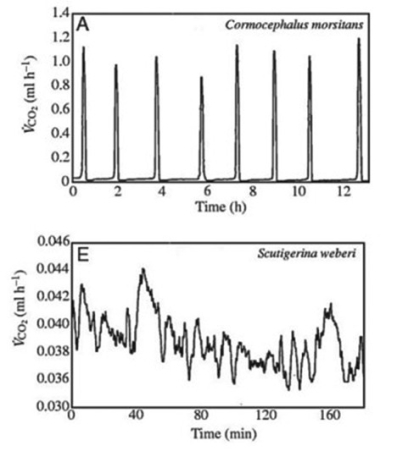Many terrestrial arthropods exchange gases with their environments by using tracheae, tubes that lead from openings (called spiracles) in the animal's exoskeleton or cuticle directly to the animal's tissues. Some arthropods can control whether their spiracles are opened or closed; opening the spiracles allows the carbon dioxide produced in the tissues to travel down the tracheae and be released outside the animal. Klok et al. measured the carbon dioxide emitted over time (represented by VCO₂) by several species of centipedes. The figures present graphs of their results for two species, Cormocephalus morsitans and Scutigerina weberi. (C. J. Klok, R. D. Mercer, and S. L. Chown. 2002. Discontinuous gas-exchange in centipedes and its convergent evolution in tracheated arthropods. Journal of Experimental Biology 205:1019-29.) Copyright 2002 The Company of Biologists and the Journal of Experimental Biology. 
Compare the graphs in the figure of carbon dioxide (CO₂) emission for Cormocephalus morsitans and Scutigerina weberi.
-What hypothesis can you make about each centipede's habitat?
A) C. morsitans lives in a habitat that provides more carbon dioxide than does S. weberi.
B) C. morsitans lives in a habitat with more predators than does S. weberi.
C) C. morsitans lives in a colder habitat than does S. weberi.
D) C. morsitans lives in a drier habitat than does S. weberi.
Correct Answer:
Verified
Q45: Imagine that you are a research chemist
Q46: Which of the following statements about bryozoans
Q46: All insects _.
A) undergo complete metamorphosis and
Q47: Many terrestrial arthropods exchange gases with their
Q48: Toilets are a modern convenience that people
Q49: Use the following information to answer the
Q51: Many terrestrial arthropods exchange gases with their
Q53: Many terrestrial arthropods exchange gases with their
Q56: Imagine that you are a graduate student
Q58: A terrestrial animal species is discovered with
Unlock this Answer For Free Now!
View this answer and more for free by performing one of the following actions

Scan the QR code to install the App and get 2 free unlocks

Unlock quizzes for free by uploading documents